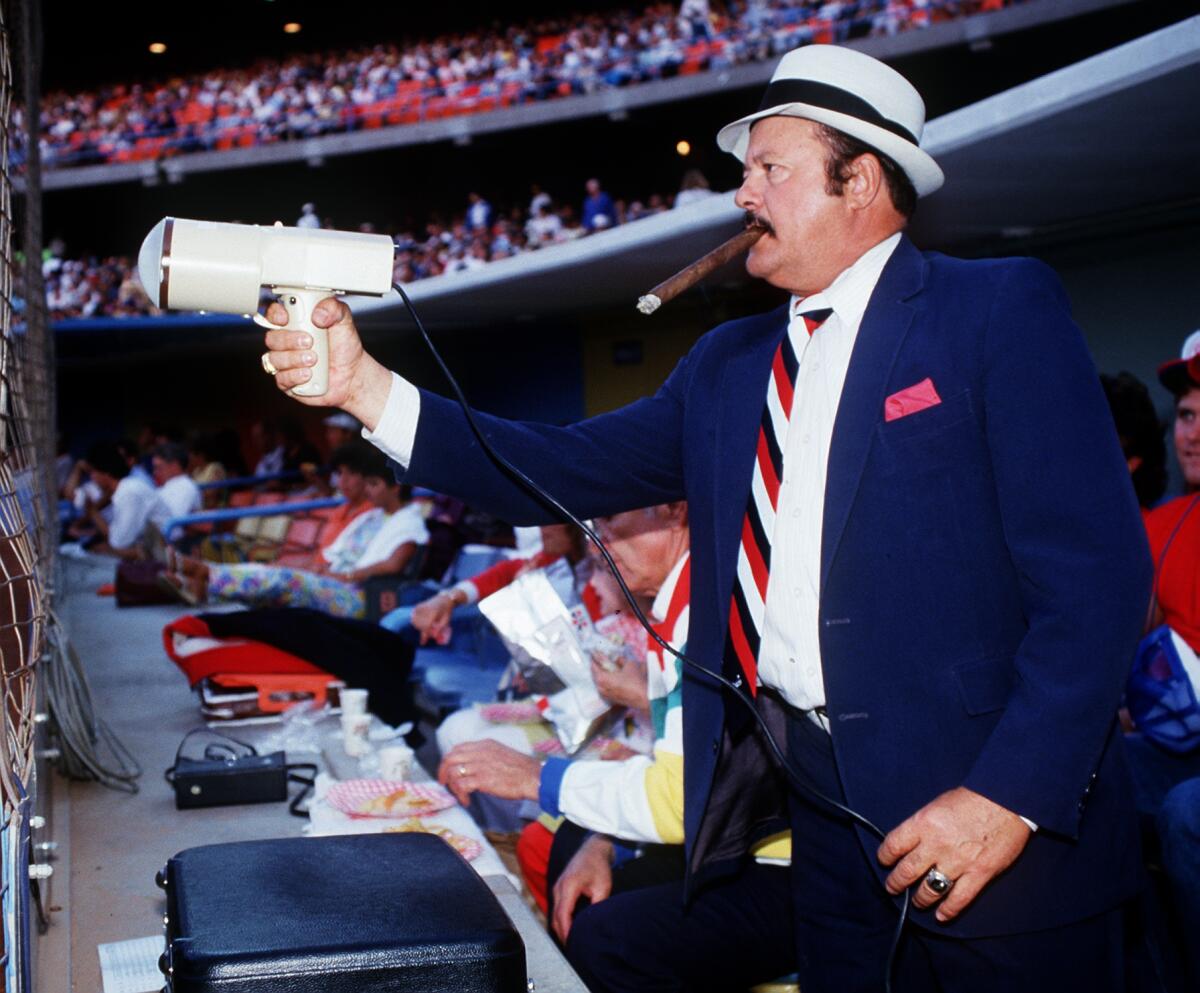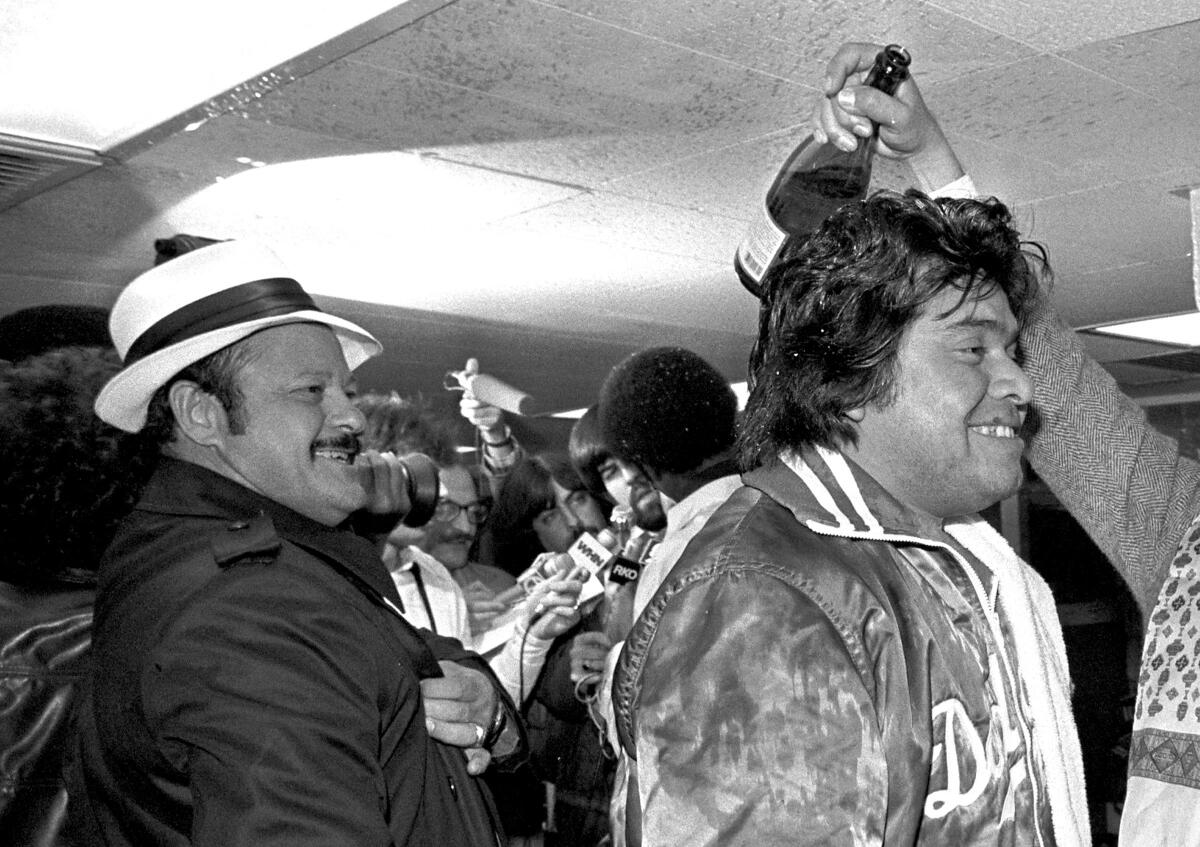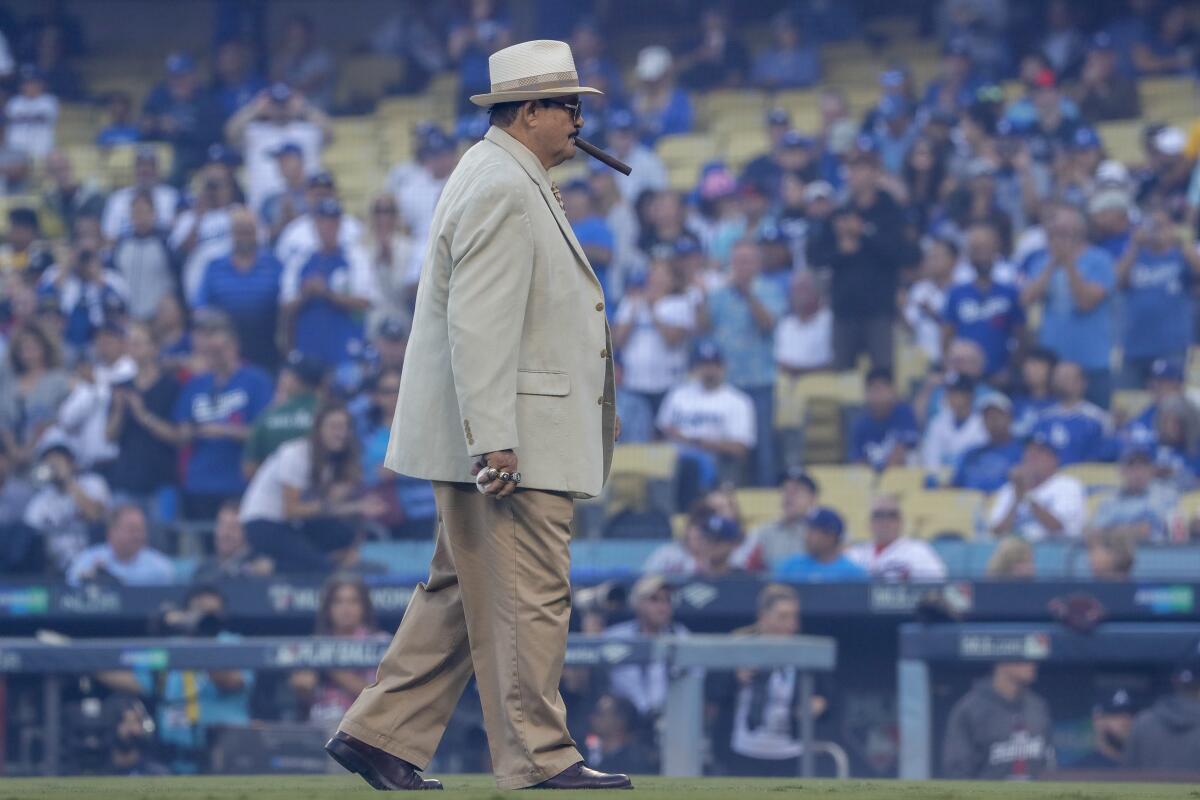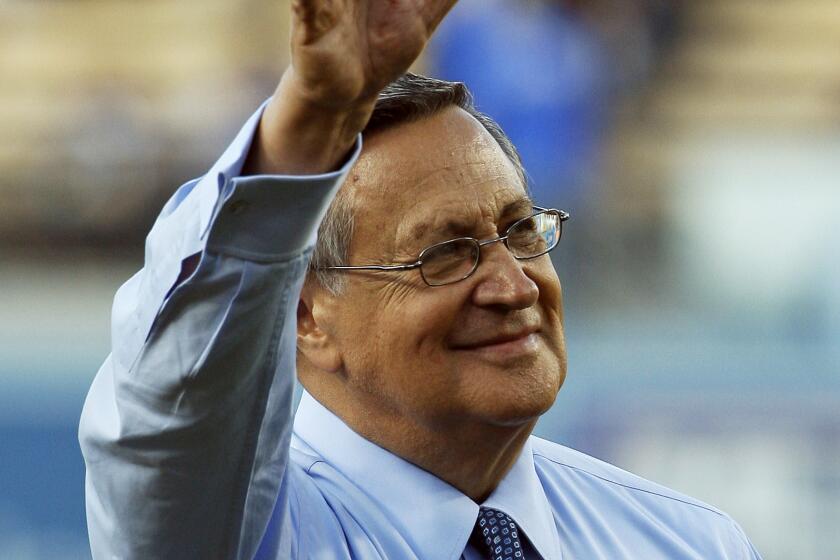With a Panama hat, cigar and radar gun, scout Mike Brito was a Dodger Stadium fixture

- Share via
He was the white Panama hat. He was the radar gun. He was the cigar. He was the heartbeat behind home plate, constant, steady, always standing, always scouting, always there.
For years, Mike Brito was a Dodger Stadium landmark, as unique as a Dodger Dog, as solid as the San Gabriel Mountains, as comforting as a ninth-inning breeze.
You may not have known his name, but you couldn’t miss his presence, and a piece of Dodgers history will be forever lost without him.
Brito died Thursday at age 87 after a 44-year career as a Dodger scout who indelibly changed the organization by turning one uncomfortable night into an eternal legacy.
In 1978, the Dodgers sent Brito to the Mexican town of Silao to check out a hot-hitting shortstop in a Mexican rookie league. The night he arrived, it was Holy Week, and all the local hotels were booked. But Brito would not be deterred. He slept on four chairs in a bus station, painfully awoke the next day, hitched a ride to the field, and dutifully took notes on the shortstop.
In the same game, he also noticed a 17-year-old pitcher who struck out 12 hitters. The kid was amazing yet completely anonymous. Brito excitedly reported his findings to general manager Al Campanis, and a year later the Dodgers signed that oddly dazzling young lefty.
Mike Brito, a longtime scout for the Dodgers who helped sign more than 30 players who appeared in the majors, died at 87, the team announced Thursday.
Name of Fernando Valenzuela.
Brito’s involvement in the creation of Fernandomania didn’t end there. Once Valenzuela joined the Dodgers organization, his greatness was forged when he learned the screwball from fellow Dodger Bobby Castillo, a pitcher Brito had also signed amid unusual circumstances.
Brito, a former minor league catcher who still played in his spare time, was facing Castillo in a semipro game in East Los Angeles. Castillo struck out Brito on a wicked full-count screwball. Brito was sold. Castillo was signed. Valenzuela eventually had his tutor. The Dodgers were never the same.
“Mike Brito’s ability to look beyond the obvious changed the direction of the franchise and baseball history,” said Mark Langill, Dodgers historian. “Whether it was finding Bobby Castillo in a semipro game on Tuesday night in Los Angeles or finding Fernando Valenzuela in the Mexican League, he never followed the crowd.”

Brito, who was Cuban, was once alerted to a top young Cuban player who was playing in a junior tournament in Canada. Brito was so enamored with the kid, he and then-Dodgers scouting director Logan White rushed to Mexico when he was being showcased and subsequently signed him.
Name of Yasiel Puig.
“Brito loved finding the obscure person and predicting stardom,” said Langill. “He loved his diamonds in the rough.”
He was also the beneficiary of some good luck. On that same trip to Mexico to see Puig, Brito was trumpeting the skills of a young catcher named Julian Leon. While signing Leon, Brito and the Dodgers also signed a couple of other locals in a group, one of whom was given a contract despite an issue with his left eye.
Name of Julio Urías.
Brito was a scout who spanned generations and fostered championships, his three World Series rings crowding his hand with a shine as bright as his constant smile.
“My heart is very heavy today,” Valenzuela said in a statement. “Mike was a great man and instrumental in my success as a baseball player on and off the field.”

Brito, who is survived by his wife Rosario and daughters Diana and Minerva, did his most compelling work away from the stadium, caring for his disabled son Miguel for more than 20 years before his death.
Through it all, he will still be forever known as the man behind home plate in the white Panama hat. Not surprisingly, his presence there is another story in itself.
He began standing behind home plate in 1978 when Campanis asked him to chart the pitches of Bob Welch. He would write the speeds and types of each pitch on a piece of paper and then deliver the results to team officials. It was quaint, but it was effective, and Campanis asked him to stand behind the plate for every game when he was in town.
He remained there for more than 20 years, even though the Dodgers never paid him extra for his efforts, and even though they could never even promise him a seat. Though his methods eventually became outdated, he would regally stand for three hours with the slowly pointed radar gun and the long stare while turning scouting into performance art. At the height of his career, he owned 25 Panama hats and 40 suits. He always wore the hat and abandoned the suit only on hot Sunday afternoons.
Jaime Jarrín, who has been the Dodgers’ Spanish-language broadcaster since 1959, announced that 2022 will be his final season behind the microphone.
Oh, and about that cigar. In his final years behind home plate he stopped smoking them because field-level fans complained about the stench. He would, instead, simply chew them.
The whole scene was so simple, so wonderful, so Dodgers.
“He eventually realized he was playing a role, and he played it perfectly,” said Langill. “Name me another scout you recognize. Name me the second-most famous scout in baseball. You can’t.”
Even if you didn’t know Mike Brito, you knew Mike Brito, the author of a grandiose Dodgers’ career that today deserves the raising of an ancient radar gun and the tip of a white Panama hat.

More to Read
Are you a true-blue fan?
Get our Dodgers Dugout newsletter for insights, news and much more.
You may occasionally receive promotional content from the Los Angeles Times.












